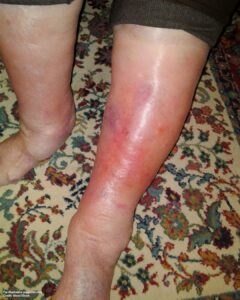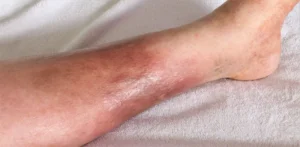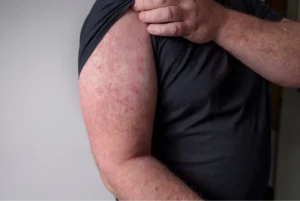The skin, often described as the body’s largest organ, does far more than just cover our bones and muscles. It serves as a protective barrier, shielding us from germs, bacteria, and harmful environmental factors. However, this protective wall is not impenetrable. Under certain circumstances, bacteria can slip through even the tiniest cut or crack in the skin, leading to infections. One such infection, which develops suddenly and can leave a person feeling extremely unwell, is known as erysipelas.
The reassuring part is that although erysipelas can sound alarming, with the right medical treatment, most people recover fairly quickly and without lasting damage. Still, understanding what this condition looks like, what causes it, and how to treat or prevent it is extremely important.
What Exactly Is Erysipelas?
Erysipelas is a bacterial infection of the skin that specifically targets the uppermost layers. The culprit behind most cases is a bacterium called Streptococcus pyogenes. This is a germ that commonly lives harmlessly on our skin or in our throats. For the most part, it doesn’t cause problems. But when it finds a way into the body — through a scratch, insect bite, cut, or any small break in the skin — it can lead to a rapid and painful infection.

Though it might not be a household name, erysipelas is more common than many people realize. It has the potential to affect anyone, regardless of age or lifestyle, but it tends to appear more often in:
- Older adults
- Young children
- People with chronic health issues or weakened immune systems
How Does Erysipelas Appear and Feel?
One of the most distinct features of erysipelas is the appearance of a bright red patch of skin that develops suddenly. Unlike other skin infections, erysipelas typically has sharply defined, raised edges, as though someone has drawn a visible line around the inflamed area.
The affected patch of skin usually feels:
- Warm to the touch
- Swollen or puffy
- Painful or tender
- The infection is most commonly seen on the face (especially the cheeks and nose) and on the legs, although it can appear elsewhere.
In addition to visible skin changes, people often experience other general symptoms of illness, including:
- Fever and chills
- General fatigue or weakness
- Muscle aches or headaches
- Swollen lymph nodes near the infected site

What Leads to Erysipelas?
The infection begins when bacteria gain entry through the skin barrier. It doesn’t require a large wound — even a tiny opening is enough. Some frequent entry points include:
- Small scratches or cuts
- Insect or animal bites
- Cracks in the skin caused by fungal infections like athlete’s foot
- Ulcers or surgical wounds
Certain individuals are more vulnerable due to underlying health issues. Risk factors include:
- Lymphedema or poor circulation, leading to leg swelling
- Diabetes, which reduces the skin’s ability to fight infections
- A weakened immune system, whether from illness or medication
- Obesity, which can cause additional skin folds, cracks, and moisture buildup
Is Erysipelas Dangerous?
While erysipelas is not usually life-threatening, it is not something that should ever be ignored. If treatment is delayed, the infection can spread deeper into the tissues and progress into cellulitis, a more serious condition that requires longer treatment.
In rare but serious cases, the bacteria can even enter the bloodstream, leading to sepsis — a potentially life-threatening complication.
The encouraging news is that, with prompt diagnosis and treatment, most people with erysipelas recover quickly and completely.
How Do Doctors Treat Erysipelas?
The cornerstone of treatment is antibiotics, most often penicillin. For those allergic to penicillin, alternative antibiotics are prescribed. Depending on how severe the infection is, antibiotics may be:
- Taken orally at home
- Administered through an IV in a hospital setting
In addition to antibiotics, doctors typically recommend supportive care measures such as:
- Resting and elevating the affected limb (if the infection is in the leg) to help reduce swelling
- Staying well hydrated by drinking plenty of fluids
- Using over-the-counter pain relievers such as ibuprofen or paracetamol to ease discomfort and reduce fever
- Keeping the infected skin area clean and dry to avoid worsening the condition
Most people notice improvement within a few days of starting treatment, though the skin redness may take longer to completely fade.
Can Erysipelas Return?
Unfortunately, erysipelas can sometimes recur. People who have chronic health conditions, ongoing leg swelling, or recurrent fungal infections are especially prone to repeated episodes.
For those who experience frequent recurrences, doctors may consider:
- Long-term preventive antibiotics
- More rigorous skin care routines
- Specialized treatments to address underlying risk factors
How Can You Prevent Erysipelas?
Prevention begins with proper skin care. Simple steps can significantly reduce your risk:
- Wash and moisturize skin regularly to avoid cracks
- Treat athlete’s foot and other fungal infections promptly
- Use insect repellent or wear protective clothing to avoid bites
- Keep wounds clean, disinfected, and covered until healed
- Work with your doctor to manage chronic conditions such as diabetes, obesity, or circulation problems

When Should You See a Doctor?
You should seek medical care promptly if you notice any of the following warning signs:
- A painful, red, and warm area of skin that spreads rapidly
- Fever, chills, or overall feelings of illness
- Swelling, tenderness, or redness that does not improve over time
Erysipelas responds extremely well to antibiotics, but the key is early treatment. Delaying medical attention only increases the risk of complications.
Final Thoughts
Though the medical term may sound intimidating, erysipelas is essentially a sudden bacterial skin infection that requires swift treatment. Its distinctive bright red patches, raised edges, and sudden onset make it easier to recognize compared to other skin conditions.
The takeaway is simple: don’t ignore the signs. If you or someone close to you develops these symptoms, seek medical help immediately. With antibiotics and supportive care, most people recover quickly, with no lasting damage.
At the same time, remember that prevention plays a huge role. By caring for your skin, addressing minor wounds promptly, and managing any underlying health conditions, you can significantly lower your risk of developing erysipelas again in the future.
In short, erysipelas is treatable, preventable, and manageable — but only if you act quickly.


